Minimal Question:
def smooth(indicator, aggregation, tick):
storage.ZZZ = []
storage.ZZZZ = []
is the pertinent part of my definition, when I call that definition I'm using:
MA_now_smooth = smooth(MA, IN, I)[-1]
where MA is an input array, IN and I are constants; the definition is further defined below but ultimately returns the last input to storage.ZZZZ. What I want is to create custom storage objects that are named according to the "indicator" input so that the persistent variables don't overlap when calling upon this definition for myriad array inputs.
ie
smooth(MA, IN, I)[-1]
should create:
storage.ZZZ_MA
storage.ZZZZ_MA
but
smooth(MA2, IN, I)[-1]
should create:
storage.ZZZ_MA2
storage.ZZZZ_MA2
In Depth Question:
I'm creating an Simple Moving Average smoothing definition for TA-lib indicators at tradewave.net; TA-lib is a library of black box functions that give "Financial Technical Analysis" array outputs for things like "moving average" "exponential moving average" "stochastic" etc. My definition is a secondary simple smoothing of these TA-lib functions.
I'm having to do this because when "aggregating" candles counting backwards from current, I'm getting "wiggly" outputs; you can read more about that here if you need background: https://discuss.tradewave.net/t/aggregating-candles-some-thoughts
My definition code works well to create a list of smoothed values when smoothing a single indicator "MA"; a TA-lib array:
import talib
def smooth(indicator, aggregation, tick):
import math
A = int(math.ceil(aggregation/tick))
if info.tick == 0:
storage.ZZZ = []
storage.ZZZZ = []
storage.ZZZ.append(indicator[-1])
storage.ZZZ = storage.ZZZ[-A:]
ZZZ = sum(storage.ZZZ) / len(storage.ZZZ)
storage.ZZZZ.append(ZZZ)
storage.ZZZZ = storage.ZZZZ[-250:]
return storage.ZZZZ
def tick():
I = info.interval
period = 10
IN = 3600
instrument = pairs.btc_usd
C = data(interval=IN)[instrument].warmup_period('close')
MA = talib.MA(C, timeperiod=period, matype=0)
MA_now = MA[-1]
MA_now_smooth = smooth(MA, IN, I)[-1]
plot('MA', MA_now)
plot('MA_smooth', MA_now_smooth)
However, when I attempt to smooth more than one indicator with the same definition, it fails because the persistent variables in the definition are the same for both MA and MA2. This does not work:
import talib
def smooth(indicator, aggregation, tick):
import math
A = int(math.ceil(aggregation/tick))
if info.tick == 0:
storage.ZZZ = []
storage.ZZZZ = []
storage.ZZZ.append(indicator[-1])
storage.ZZZ = storage.ZZZ[-A:]
ZZZ = sum(storage.ZZZ) / len(storage.ZZZ)
storage.ZZZZ.append(ZZZ)
storage.ZZZZ = storage.ZZZZ[-250:]
return storage.ZZZZ
def tick():
I = info.interval
period = 10
IN = 3600
instrument = pairs.btc_usd
C = data(interval=IN)[instrument].warmup_period('close')
MA = talib.MA(C, timeperiod=period, matype=0)
MA2 = talib.MA(C, timeperiod=2*period, matype=0)
MA_now = MA[-1]
MA2_now = MA2[-1]
MA_now_smooth = smooth(MA, IN, I)[-1]
MA2_now_smooth = smooth(MA2, IN, I)[-1]
plot('MA', MA_now)
plot('MA2', MA2_now)
plot('MA_smooth', MA_now_smooth)
plot('MA2_smooth', MA2_now_smooth)
What I would like to do... and don't understand how to do:
I'd like for the definition to create a new persistent storage object for each new input and I'd like for the names of my objects to detect the name of the "indicator" input, ie:
storage.ZZZ_MA
storage.ZZZZ_MA
ZZZ_MA
for the "MA" smoothing and
storage.ZZZ_MA2
storage.ZZZZ_MA2
ZZZ_MA2
for "MA2" smoothing
I would like to be able to reuse this definition with many different array inputs for "indicator" and for each instance use the name of the indicator array appended to the persistent object names used in the definition. For example:
storage.ZZZ_MA3
storage.ZZZ_MA4
etc.
In the instances below info.interval is my tick size of 15 minutes (900 sec) and my aggregation was 1 hour (3600 sec)
With the single output of "MA" and correct smoothing

With dual outputs of "MA" and "MA2" I'm getting incorrect smoothing
In the second image I'm looking for a two "smooth" lines one in the middle of the wiggly red plot and the other in the middle of wiggly blue plot. Instead I'm getting two identical wiggly lines (purple & orange) that split the difference. I understand why, but I don't know how to fix it.
1) please show me how
2) please tell me what I'm looking to do is "called" and point me to some tags/posts where I can learn more.
Thanks for your help!
LP

